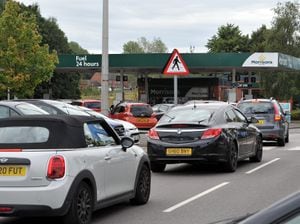Fuel crisis: Top driving tips to save petrol as pumps run dry
Running low? The fuel crisis has offered us all a reminder of just how we take filling up the car for granted.

Once you finally manage to find a garage with supplies, it is important to look after what you have got.
Here, courtesy of the RAC, are some fuel-saving tips that are worth noting even when the queues diminish. More details and videos can be found on its website. The advice will help you drive more efficiently and save you a few pounds over the course of a year.
1. Look after your car
Maintenance and servicing are important as they improve the efficiency of your vehicle, helping with fuel consumption.
It is particularly important to make sure your tyres are inflated to the correct pressure as indicated in your owner’s manual, as under-inflated and over-inflated tyres both adversely affect fuel economy. Tyre pressures will vary depending on the load you are carrying: if you have four passengers and luggage then you will need your tyres inflated to the maximum recommended pressures.
2. Go easy on the pedal
Excessive speed is the biggest fuel-guzzling factor so having a light right foot and ensuring all acceleration is gentle is very important to fuel-efficient driving.
Of course you will always have to accelerate a number of times on a journey, but that doesn't mean you have to pull away like you're on the starting line at Silverstone!
Probably the biggest secret to achieving high miles per gallon is driving in the highest possible gear for your vehicle while keeping within the speed limit. The best advice in urban areas is to change up through the gears as quickly as you can with the lowest revs possible. Remember: the faster an engine spins, the more fuel it uses.
This optimum fuel economy speed will be different for every car, but when the RAC completed its Record Road Trip in the Audi A6 ultra, that particular car’s optimum fuel economy speed was 52mph in seventh gear on the flat.
Over the years the speed of 56mph has often been talked about as being the optimum speed. This was due to the old fuel consumption test being run at three speeds: urban, 56mph and 75mph – and 56mph was always, unsurprisingly, the most efficient of these. Typically, according to the RAC, cars are most efficient at 45-50mph.
3. Keep moving
Keeping the car moving at the right speed helps with fuel economy. Slowing down and having to accelerate again naturally uses more fuel. Try to drive smoothly, not overly using accelerator and brakes. When slowing down, it’s important to remain in gear as the fuel cut-off switch in a fuel injection engine is then activated, meaning virtually no fuel is used while braking.
Try to anticipate what’s going to happen in front of you by looking well ahead. This way you’ll see the traffic lights on red meaning you can ease back on the accelerator or slow down naturally and potentially keep moving as opposed to coming to a stop. Driving up hills destroys fuel economy. When you spot a hill coming try to accelerate a little before you reach it, then ease off as you drive up. The extra momentum should be enough to minimise additional fuel consumption.
4. Save cruise control for motorways
The most fuel-efficient roads in the country are motorways, where you can leave the car in top gear and gently cruise along, using minimal fuel.
Cruise control only aids fuel economy when driving on a constant flat surface, hence why it is usually best reserved for motorway driving.
One of the keys to saving fuel is driving at a constant speed - cruise control can do this effectively on flat surfaces, making your driving as fuel efficient as possible by negating unnecessary acceleration.
However, if you were to use your cruise control regularly, not on flat roads, you would encounter problems that would increase your fuel consumption.
5. Stay aerodynamic
Don’t leave your roof bars and roof box on because they create wind resistance and cause your car to use more fuel through the ‘drag’ effect. This is increased the faster you drive.
According to the Energy Saving Trust an empty roof rack adds 16 per cent drag when driving at 75mph. At the same speed a roof box adds 39 per cent, making your vehicle much less fuel efficient.
Even those little flags you can affix to your vehicle to show support for your football team during the World Cup can decrease your miles per gallon!
Driving with an open window also has a similar effect.
6. Be selective with AC
Don’t use your air conditioning unless you really have to as it uses engine power and therefore increases fuel consumption.
This goes for heat as well as cooling, so try to dress for the weather, even inside your car, if fuel efficiency is a big concern.
7. Keep your engine warm
Consider making one round trip rather than several short trips. Once the engine is warm it will operate at its most efficient whereas several cold starts will increase fuel consumption even though the total mileage could be the same
The RAC’s Record Road Trip team kept going almost continuously, only stopping for 20 minutes at a time on the way to setting a world record of driving through 14 countries on one tank of fuel. That was 1,158.9 miles, driving at an average speed of 45mph and achieving 75.9 miles per gallon.
8. Lighten the load
While this isn’t going to make the biggest difference to your miles per gallon figures it stands to reason that the heavier a vehicle is, the more fuel it will use.
For that reason, don’t keep unnecessary items in your boot as they all add weight to your vehicle, which is not going to help your fuel economy in the long run.
